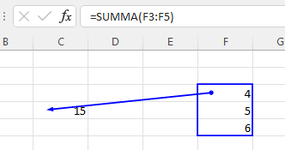FilleFrella44
New Member
- Joined
- Oct 11, 2022
- Messages
- 20
- Office Version
- 365
- Platform
- Windows
Hello,
I'm wondering if you can change the colour of a cell based on the colour of another. The idea is to change the colour of one cell, then have several cells (which are seeds/children of the origional cell) to change to the same colour.
See below/attatched for desired end-result. I wonder if this can be done with conditional formating of any sort, or if I have to use VBA-code. And if so, can I use VBA to dynamically find the cells connected to the original?


Regards and thanks in advance,
FilleFrella
I'm wondering if you can change the colour of a cell based on the colour of another. The idea is to change the colour of one cell, then have several cells (which are seeds/children of the origional cell) to change to the same colour.
See below/attatched for desired end-result. I wonder if this can be done with conditional formating of any sort, or if I have to use VBA-code. And if so, can I use VBA to dynamically find the cells connected to the original?
Regards and thanks in advance,
FilleFrella






